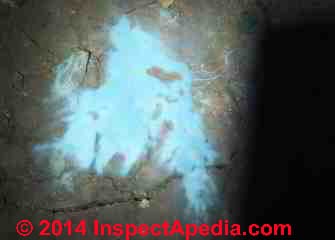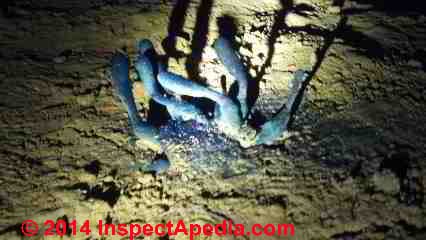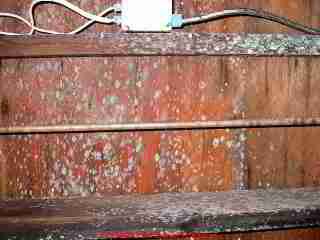 Crawlspace Mold: How to Find, Test, & Prevent Mold in Crawl Spaces
Crawlspace Mold: How to Find, Test, & Prevent Mold in Crawl Spaces
- POST a QUESTION or COMMENT about the cause, health hazards, clean-up, and prevention of mold in building crawl spaces
Mold in crawl areas:
This article explains how to find and deal with mold in building crawl spaces. We explain how to spot crawl space mold contamination, when mold testing is appropriate, the risk of mold-contaminated crawl space insulation, the causes of crawl space mold, and how to clean or remove crawl space mold as well as how to prevent moldy crawl spaces in the first place.
InspectAPedia tolerates no conflicts of interest. We have no relationship with advertisers, products, or services discussed at this website.
- Daniel Friedman, Publisher/Editor/Author - See WHO ARE WE?
CRAWLSPACE MOLD: finding the problem mold, allergens, or other particles in crawl spaces
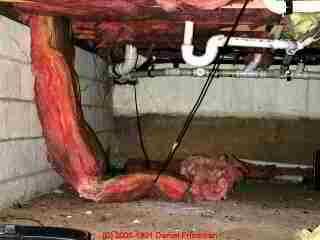 This crawl space inspection procedure for mold helps identify the presence of or locate the probable sources of mold reservoirs in buildings, and helps decide which of these need more
invasive, exhaustive inspection and testing
This crawl space inspection procedure for mold helps identify the presence of or locate the probable sources of mold reservoirs in buildings, and helps decide which of these need more
invasive, exhaustive inspection and testing
The photograph at page top shows extensive fungal growth on the underside of subflooring and on wood framing supporting a wood floor over a very damp crawl space. Depending on the mold genera/species, if an airborne fungus is present at high levels in a crawl space, spores of that mold may move easily to upper levels in the building.
We very often find that insulation in crawl spaces has become a problem mold reservoir. Some of these molds move easily from the crawl area up into the living space.
For example, Penicillium sp. or Aspergillus sp. spores, which can be as
small as about one micron in diameter, are so tiny and light that they can move much like a gas in a building.
These tiny spores rise in upwards-moving air currents as warm air, rising to upper building levels, creates a slightly lower air pressure in lower building areas such as basements and crawl spaces.
Depending on the tightness of construction, and the presence or absence of hot air or central air conditioning systems which themselves may increase indoor air particle movement, the rate of movement of particles from a moldy crawl space can vary widely.
In some instances we have found rather high levels of airborne mold spores and mold spores in settled dust that tracked directly to the moldy crawl space.
In other instances we found that there was not much air and particle movement upwards from a crawl space or basement, until specific triggering conditions occurred.
These included opening of a basement door, or in the case of crawl spaces, opening upper floor windows or turning on a whole house exhaust fan. These conditions led to a significant increase in movement of crawl space (or basement) mold from lower building areas into the living space.
First aid for moldy crawl spaces - what to do about mold in a crawl space
- Watch out: Do not enter or work in a moldy area without wearing proper respiratory and other personal protection.
See CRAWL SPACE SAFETY ADVICE - Evaluate the history of water entry, dampness, ventilation, listing the factors conducive to fungal growth such as:
- Present or past wet conditions, whether "once", episodic, or recurrent water entry
- Marginal or no ventilation. Actually I prefer to stop trying to vent crawl spaces since when we want venting it's usually inadequate, and depending on weather conditions venting a crawl space can actually increase its moisture level and make matters worse. A preferred approach is to dry out, enclose, and seal a crawl space under a building, making it into conditioned space.
- Exposed dirt. If the crawl space has a dirt floor, put down 6-mil plastic over the dirt to reduce moisture movement from the soil into the crawl space. Also see MOLD ON DIRT FLOORS
- Presence of fiberglass or other fibrous insulation
- Fix outside conditions that are causing wet crawl space conditions such as roof gutter or downspout spillage by the building foundation.
- Fix inside conditions that wet crawl spaces, such as plumbing leaks or improper ventilation.
- Look for visible mold:
- Inspect the exposed sides of all framing, joists, girders, posts
- Inspect the exposed under-side of subflooring of the floor overhead. See our warning about mold growth on pine boards discussed at Attic inspections above.
- Special screening tests may assist in evaluating the condition in inaccessible crawl spaces.
- See HOW TO LOOK FOR MOLD
and HIDDEN MOLD, HOW TO FIND - Prevent mold movement into the living area: As with a moldy basement, keep openings between the crawl space and living space closed as much as possible.
- Remove wet or mold-suspect insulation.
- Test representative samples of mold before going to a major expense to be sure you're not just looking at cosmetic mold on framing lumber,
or at something else that is not even mold.
If a large area of visibly moldy material is present (more than 30 sq .ft.) professional cleaning and remediation are probably in order. In that case, a building inspection and preparation of a mold remediation plan is a good idea - that work should be performed by someone who has no conflicts of interest - in other words, not by the mold cleanup company or their agent.
Follow any costly mold remediation job with a clearance inspection and test before you make final payment. - Review MOLD PREVENTION GUIDE Correct the Causes of Mold and Prevent Indoor Mold or other indoor environment problems
Risks of Mold Contamination in fiberglass insulation in a crawl space
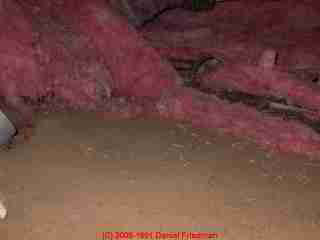
These photos show crawl space fiberglass which had fallen onto the dirt crawl space floor.
We can pretty much count on this material to be mold contaminated unless the building was in an arid climate.
You can expect to find rodent contamination as well in insulation in this condition.
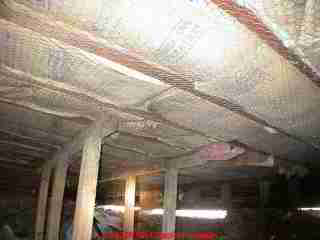
This photo shows crawl space fiberglass which the installer supported by chicken wire. The crawl space was pretty drafty which we might hope would keep it dry and less moldy.
However we might expect to find a nice mouse colony here, and depending on weather variations and crawl space flooding, this insulation too is at risk of becoming a mold reservoir.
We'd have preferred to use a solid foam insulation in conditions like this.
Key building water entry diagnosis and cure articles:
- BASEMENT WATERPROOFING - use of sealers to help keep basements and crawlspaces dry
- BASEMENT LEAKS, INSPECT FOR - where and how water gets into basements and crawl spaces
- CRAWL SPACE DRYOUT PROCEDURES - details about curing wet or damp crawl spaces.
- EFFLORESCENCE SALTS & WHITE DEPOSITS - these white deposits are a great indicator of where moisture is penetrating a foundation
- HUMIDITY CONTROL & TARGETS INDOORS - so how dry should a building be for comfort and mold prevention?
- MOISTURE CONTROL in BUILDINGS - master list of detecting and controlling building moisture levels
- MOISTURE PROBLEMS: CAUSE & CURE - moisture and building energy loss
- SUMP PUMPS GUIDE - how and where to install a sump pump as an emergency backup against basement or crawl space flooding
- WATER ENTRY in BUILDINGS - causes and cures of un-wanted building leaks in all areas
- WET BASEMENT PREVENTION - how to stop basement flooding
This article is part of our series: MOLD in BUILDINGS which describes how to find mold and test for mold in buildings, including how and where to collect mold samples using adhesive tape - an easy, inexpensive, low-tech but very effective mold testing method.
Crawlspace Mold Research
- Hall, T., B. Wessén, and Lars-Olof Nilsson. MICROBIAL GROWTH AND SECONDARY EMISSIONS–THEIR MAIN CAUSES IN SWEDISH PROBLEM BUILDINGS [PDF] Healthy Buildings 2006 (2006): 353-364.
Introduction excerpt:
In Scandinavia it has been amply demonstrated that some types of construction sustain mould growth while in others abnormal chemical emissions also occur. Both types of damage are due to harmful moisture. It is also well known that occupants sometimes have pronounced health problems associated with living or working in damp buildings. - Isaksson, Tord, Sven Thelandersson, Annika Ekstrand-Tobin, and Pernilla Johansson. CRITICAL CONDITIONS FOR ONSET OF MOULD GROWTH UNDER VARYING CLIMATE CONDITIONS [PDF] Building and environment 45, no. 7 (2010): 1712-1721.
Abstract:
A performance-based service life design format based on climatic exposure on one hand and “resistance” of materials against mould growth on the other hand, is presented in this paper.
A limit state for onset of mould growth is defined as the occurrence of traces of mould observed by microscopy. A dose–response model is proposed by which onset of mould growth can be predicted for an arbitrary climate history of combined relative humidity ϕ and temperature T.
The model is calibrated and verified against a comprehensive set of experimental data published by Viitanen et al. [Viitanen H, Ritschkoff A-C. Mould growth in pine and spruce sapwood in relation to air humidity and temperature. Uppsala: Swedish University of Agricultural Sciences, Department of Forest Products; 1991. Report No. 221, 49 p.; Viitanen H. Modelling the time factor in the development of mould fungi – effect of critical humidity and temperature conditions in pine and spruce sapwood. Holzforschung 1997;51(1):6–14; Viitanen H. Modelling the time factor in the development of brown rot decay in pine and spruce sapwood – the effect of critical humidity and temperature conditions. Holzforschung 1997;51(2):99–106; Viitanen H, Bjurman J. Mould growth on wood under fluctuating humidity conditions. Material und Organismen 1995;29(1):27–46] describing mould development on spruce and pine sapwood as a function of climatic exposure.
The model is applied to predict time to onset of mould growth under natural outdoor climate (under shelter) as well as mould development in building attics and in crawl space foundations. The predicted response shows reasonable agreement with experimental observations and proven experience, although biological processes of this type display great variability.
The results show that a generally applicable, quantitative model can be used as a powerful tool for moisture safe design in practice. The model is designed to facilitate continuous improvement of prediction capability by further laboratory testing of various materials under specified climate conditions. In combination with currently available building physics software the model is suitable for moisture safe design of wood-based components in the building envelope. - Richter, Jan, and Kamil Staněk. MOISTURE SAFE AND MOULD FREE CRAWL SPACES: STATE-OF-THE-ART AND DESIGN OF FULL-SCALE EXPERIMENT Energy Procedia 78 (2015): 2754-2759.
Abstract:
This paper reviews common problems and approaches in the design of modern crawl spaces. It also presents a full-scale experimental set-up and a set of laboratory experiments designed to further investigate their hygrothermal and microbiological behaviour. This work is a part of a long-term research project to determine the basic rules for designing naturally ventilated crawl spaces in the Central European climate that would be moisture-safe, mould-free and with minimum maintenancerequirement
...
Reader Comments, Questions & Answers About The Article Above
Below you will find questions and answers previously posted on this page at its page bottom reader comment box.
Reader Q&A - also see RECOMMENDED ARTICLES & FAQs
On 2019-01-06 - by (mod) -
Carrie
Try the page top EXPERTS DIRECTORY since this problem won't be well-served by mere text or email consults.
On 2019-01-04 by Carrie
HELP PLEASE. I'm having trouble finding anyone local to help me. I am in Florida. Ex-hub was owner/builder ... mistake #1.
Against the advice of an engineer & a general contractor and unbedknownst to me (mistake #2 & #3) he made the crawlspace / stem wall with a concrete pad under and essentially turned it into an improperly vented, unsealed basement.
THREE sides of the house have dirt against it and one side of the house is against a hill (would not be easy to move dirt away).
Within 2 weeks of moving into my brand new log home, there is mildew (hopefully not yet mold).
I see that the best idea may be to seal the 8 vents and put some kind of concrete sealer on the inside of the stem wall and then put in a dehumidifier but I cannot find anyone who will even come out & look at it. The only companies are mold remediators but the want insurance $ and don't do stem walls / basements. How can I find someone who will help? Do I need a mechanical contractor or an HVAC or a concrete person or someone else?
On 2017-10-05 by Gary Wamsley
Can you provide a range of cost to mitigate an average Mold/Fungi condition in the 3000 SF crawl space of a residential house... It sets up 4 feet on Concrete blocks, has A/C ducts attached to floor and fiberglass insulation between to floor beams. ?? Space is mostly enclosed by face brick . Has vent openings every 4-5 feet.
On 2017-01-10 - by (mod) -
The rock was probably necessary in the builder's experienced judgement. Not many builders spend even a dime on something that they thought was unnecessary since, as they've told me, their customers won't pay for it. The rock may be to cover a soft soil, a muddy surface, or to improve drainage in a crawl area that drains to a low point and sump, or simply to give a more level surface. The plastic is important. If crawling on it doesn't wreck your knees it might still puncture the plastic if the rock is sharp. So take care.
On 2017-01-09 by Peter
The builder of our house put rock down on the dirt, which was subsequently covered by clear plastic (I don't know how thick it is), and they did not tape the plastic together.
My question is this, is the rock really necessary?
On 2016-05-08 - by (mod) -
Dennis:
I don't agree that crawl spaces and attics are close to outdoor air in their content, though I agree that depending on construction and venting details some outdoor air may be entering both places.
Air sampling for mold, by itself, is never effective under most conditions, as there are many test conditions that can cause 1-4 orders of magnitude variation in "air test" results. A test that shows "no problem" could be dead wrong.
Search InspectApedia.com for MOLD AIR TEST VALIDITY to read details.
On 2016-05-07 by Dennis Catalano
Since crawl spaces and attics have a similar air environment consistent with the outdoor air, is air sampling for mold effective?
On 2015-11-12 by Anonymous
Lynn, the materials cost less than $100. for a typical crawl area. Labor cost depends on
Ease of access
Working space
Surface preparation needed including
Cleanup or removal of debris, grading, drainage
$200. and up
On 2015-11-11 by Lynn
How much does it cost per square foot to put vinyl sheet over crawl space dirt?
Reader Question about Mold in Dirt Crawl Space
Hi I have attached a few pics of the mold growth on my dirt crawl space each pic is isolated and no further spread is seen anywhere else. I was actually shocked to see this strange looking growth. I do keep the crawl vents open but there is no forced air movement at all. Please assist as to how to safely remove.
The house sustained a fire in may of 2014 and the ac system has been off since. There are fans running in house though. The only power to crawl space is to the sump pumps that discharge any water to the outside via pipes which none of the pics of the mold spores / mushrooms are even close to the sump liners of perimeter pipe in perimeter ditch.
There is no black plastic liner on dirt floor and no floor joist insulation, I removed all several years back when I dug my perimeter ditch and sump pits with the plastic liners. Thanks for any guidance! - G.E. 9/8/2014
Reply:
Nice photos - that blue fungus is not one I've seen before. I've posted all of your photos also
Most likely these grow where you see them because of a combination of moisture and organic material spilled on or in the soil.
Certainly you describe a damp or wet crawl area and one that was previously flooded (during fire extinguishment) - all of which invite fungal growth therein.
You can dig out (just an inch or so) the visible mold, toss it into the woods or into garbage, then put down plastic, and take other steps to dry out the area.
Probably more important would be mold growth on the exposed wood framing or in insulation if there is some in the crawl area. For that topic
or for more about the development of mold in fiberglass insulation
see FIBERGLASS INSULATION MOLD
See CRAWL SPACE DRYOUT - live link just below - for procedures to prevent further mold problems in the crawl area.
...
Continue reading at CRAWL SPACE DRYOUT or select a topic from the closely-related articles below, or see the complete ARTICLE INDEX.
Or see these
Recommended Articles
- CRAWL SPACES - home
Suggested citation for this web page
CRAWLSPACE MOLD ADVICE at InspectApedia.com - online encyclopedia of building & environmental inspection, testing, diagnosis, repair, & problem prevention advice.
Or see this
INDEX to RELATED ARTICLES: ARTICLE INDEX to MOLD CONTAMINATION & REMEDIATION
Or use the SEARCH BOX found below to Ask a Question or Search InspectApedia
Ask a Question or Search InspectApedia
Try the search box just below, or if you prefer, post a question or comment in the Comments box below and we will respond promptly.
Search the InspectApedia website
Note: appearance of your Comment below may be delayed: if your comment contains an image, photograph, web link, or text that looks to the software as if it might be a web link, your posting will appear after it has been approved by a moderator. Apologies for the delay.
Only one image can be added per comment but you can post as many comments, and therefore images, as you like.
You will not receive a notification when a response to your question has been posted.
Please bookmark this page to make it easy for you to check back for our response.
IF above you see "Comment Form is loading comments..." then COMMENT BOX - countable.ca / bawkbox.com IS NOT WORKING.
In any case you are welcome to send an email directly to us at InspectApedia.com at editor@inspectApedia.com
We'll reply to you directly. Please help us help you by noting, in your email, the URL of the InspectApedia page where you wanted to comment.
Citations & References
In addition to any citations in the article above, a full list is available on request.
- A BRIEF GUIDE to MOLD, MOISTURE, and YOUR HOME, [PDF] U.S. Environmental Protection Agency US EPA - includes basic advice for building owners, occupants, and mold cleanup operations. See http://www.epa.gov/mold/moldguide.htm
- In addition to citations & references found in this article, see the research citations given at the end of the related articles found at our suggested
CONTINUE READING or RECOMMENDED ARTICLES.
- Carson, Dunlop & Associates Ltd., 120 Carlton Street Suite 407, Toronto ON M5A 4K2. Tel: (416) 964-9415 1-800-268-7070 Email: info@carsondunlop.com. Alan Carson is a past president of ASHI, the American Society of Home Inspectors.
Thanks to Alan Carson and Bob Dunlop, for permission for InspectAPedia to use text excerpts from The HOME REFERENCE BOOK - the Encyclopedia of Homes and to use illustrations from The ILLUSTRATED HOME .
Carson Dunlop Associates provides extensive home inspection education and report writing material. In gratitude we provide links to tsome Carson Dunlop Associates products and services.


